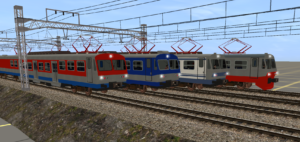
From left to right: SEPSA livery, EAV livery (refurbished units), Alifana Railway E82B and Ferrovia Bologna-Vignola E122 Series.
DOWNLOAD
All the necessary dependencies are included in this pack or are avaible on the DLS.
The two-car Firema Type E82 electric multiple unit and it’s derivatives, the E82B and E122 types, were developed in the early 1990s by the Firema company, and were intended for regional railways operating urban and suburban services.
They can be considered a mix between the ALe 724 Series, a very successful and versatile chopper-controlled electric multiple unit that had been in service with the FS since 1982, and the “Piano Ribassato” (“Low Floor”) coaches, themselves too FS rolling stock, wich had been built in two batches in 1965 and between 1973 and 1982. From the former, they inherited the chopper control, bogeys, pantographs and the front cab design, while from the latter, they inherited the low-floor bodyshell design, and most notably, the four-section folding passenger doors.
The first company to place an order for the new Firema trains was the SEPSA company, wich operated the Cumana and Circumflegrea commuter railways in the western part of Naples. SEPSA ordered six two-car sets, classified in the ET400 Series: ET401 to ET406, all of wich entered service in 1991 on both of the railway’s lines.
Following the success of the first units, SEPSA ordered another seven EMUs, wich were delivered in 1992 and entered service in the same year, classified ET407 to ET413.
At the same time, the nearby Alifana Railway was undergoing preparatory works that would’ve lead to the electrification of the line, and in 1998, the Government commission supervising the railway ordered a single EMU from Firema, with eventual plans to buy several more once the electrification had been completed.
Delivered in the same year, the unclassified two-car set was nearly identical to SEPSA’s ET400, altough the Alifana set had all of the traction equipment concentrated on one car (unlike the ET400s, where the same equipment is shared between the two cars), reason why it was given the designation “Type E82B” by Firema.
Unfortunately, due to financial issues, the Alifana railway electrification works were initially suspended, and later outright abandoned by the early 2000s, with the E82B set having never entered service (nor having ever run under it’s own power). Stored at Piedimonte Matese depot, in 2006 it was sold to SEPSA, wich re-classified it as “ET414”, altough here too, it did not enter regular service, ending up as a spare parts donor for it’s thirteen SEPSA siblings.
Also in 1998, two 2-car sets were delivered to the under-reconstruction Bologna-Vignola railway in the Emilia Romagna region. These were built at the Casaralta works in Bologna and were classified as E122, and unlike their neapolitan cousins, they had two doors per car instead of three, and a slightly lower floor. Panited in the FBV’s striking red and blue “Suburbana” livery, they started to undegro testing in 2005 (the line had been re-opened two years earlier, and was operated with ALn663 diesel railcars).
The E122s, later reclassified as ALe 122, continued their test runs thruought the years, up until 2009, when the FBV was absorbed into the FER company. By then, these chopper-controlled trains had became technically obsolete, and with the introduction of ETR350 Electric Multiple Units – the successful Stadler FLIRTs, the two ALe 122s were withdrawn and stored at one of the railway’s depots, and one year later, in 2010, themselves too were sold to the SEPTA to be used as spare parts donors.
Back to Napoli, in 2013, SEPSA was absorbed by the EAV company, and in the same year, the first ET400, unit ET401, was refurbished: air conditioning was added, bodyshells were repaired and the train recieved a new livery of blue and silver. Another set was refurbished in 2014 and a third in 2015. Six more sets are to be refurbished in the next years, but due to the to the poor financial situation of EAV, works will take a very long time.
Trivia#1
There are three versions on why the Alifana E82B never entered service: the first, according to an high-ranking Firema engineer, is because the train could not run on RFI lines as it didn’t comply with crash-worthiness regulations. The second version, according to the Depot Chief of Piedimonte Matese, was that the E82B’s electronic equipment (chopper et cetera) produced armonic interferences that disturbed RFI’s signalling systems, while the third and final version, according to a Piedimonte Matese depot worker, was that the E82B was too light to be detected by the signalling system or by automatic level crossings.
Trivia#2
The Alifana E82B never recieved any kind of classification until it was acquired by SEPSA in 2006. During it’s time on the Alifana, it was simply known by the Firema factory designation (Type E82B) or more simply, by “L’ elettromotrice” (“the electric multiple unit” – as it was the one and only EMU the Alifana railway ever owned).
Trivia#3
The two ex-FBV ALe 122s never entered in regular service on the Bologna-Vignola Line because according to a FER company official, “they were unsuited for a suburban service wich requires high accelleration and high capacity” (depsite the E122s being designed exactly for that!).
Trivia#4
The two ALe 122s underwent dynamic testing not only on the Bologna-Vignola Line, but also on the LFI and RFI lines in the Toscana region, where they reached up to 110Km/h
Bonus video: a rare recording of ET122s undergoing testing on the Bologna-Vignola Line.
